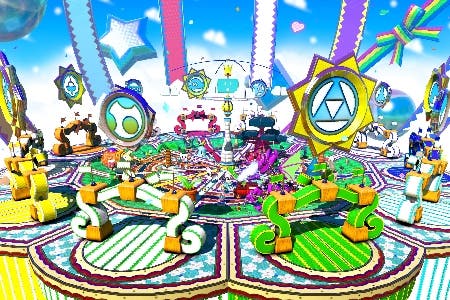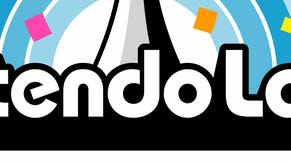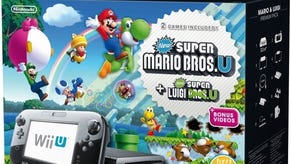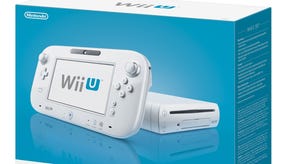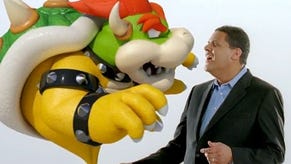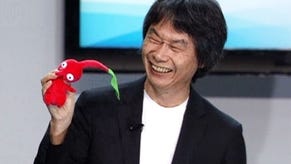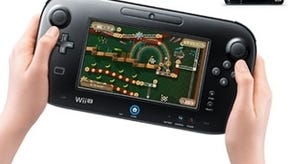Nintendo Land review
Proof or concept?
Two days from Wii U's release in the US, and we still don't quite know what it is yet. We don't have a full picture of its features or its system software or how it will work online. We don't fully understand the digital glue that will stick this beefed-up HD Wii console to its GamePad tablet controller. It's a weird console.
So - in its early days, at least - the burden of explaining Wii U will have to be shouldered by Nintendo Land. Like Wii Sports and Wii Play before it, this mini-game collection is part party game, part tech demo, part game design propaganda. It's meant as much to illustrate the potential of a novel hardware set-up as it is to entertain family and friends. To be quite honest though, it's better at the latter than it is at the former. Nintendo Land is a weird game for a weird console.
Its cute conceit, presented with perfect polish and charm, is that it's a virtual amusement park dedicated to all things Nintendo. It's somewhere your Miis stroll and cavort, dressing up as Mario or Samus or Captain Olimar before jumping into playpens where Nintendo's colourful game worlds are recreated out of stitched cloth, painted metal and shiny plastic capsule toys. It's completely disarming.
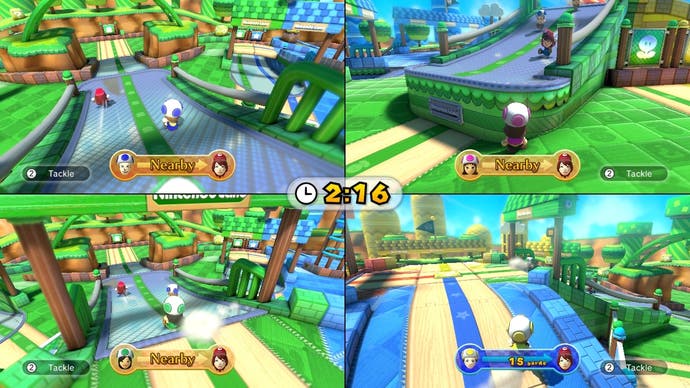
While it reels you in on the ageless appeal of classics like Zelda and Animal Crossing, Nintendo Land is not made by the same Nintendo as those games. Surprisingly, it's not made by the image-conscious, jogging-pants Nintendo of recent years, either. Instead this is the Nintendo that infiltrated the seaside bars and truck stops of the 1980s with Punch-Out!! and Balloon Fight and Mario Bros.; the Nintendo that drove a generation of schoolchildren mad with the sadistic bleeps of Game & Watch; the Nintendo that whiled away the 1970s peddling light-gun games in abandoned bowling alleys. This is the brash, testy, brawling Nintendo of the arcade. Roll up, roll up!
When it wants to be, Nintendo Land is as tough as old boots. And in games like The Legend of Zelda: Battle Quest and Donkey Kong's Crash Course, it really wants to be, acting for all the world like it's wringing a shiny coin out of you for every retry. If there's one thing to love about this compilation, it's that it's not afraid of putting off kids and grandmothers with a bit of good old-fashioned video gaming - remembering that they liked it well enough 30 years ago.
The only problem with this is the incessant explaining that it requires. The 12 games - six solo, three competitive and three co-op - cover the broadest possible range: deathmatch, dungeon crawl, rhythm action, shooting gallery, endless runner, you name it. Most of them sport some novel mechanic or control scheme, with the multiplayer ones splitting their attention between one GamePad player and up to four others using Wii remotes and the TV. So you'll spend a lot of your time with Nintendo Land either listening to the unsettling synthesized drawl of your robot guide Monita (not Nintendo's most sympathetic bit of character design ever), or explaining what to do to your friends.
"The games are all made to Nintendo's usual high standards, but their entertainment value varies a fair bit. "

The games are all made to Nintendo's usual high standards, but their entertainment value varies a fair bit. The most worrying sign here for Wii U's future is that the three competitive 'attractions' are very similar variations on a theme. That theme, if you want to show off, is the rare 2003 GameCube/GBA experiment Pac-Man Vs.; if you don't, it's tag.
Mario Chase is the simplest variation, casting the GamePad player as Mario, running away from up to four Toads in a circular maze. Mario can see where the Toads are, but they have to communicate amongst themselves to track him down. It's a basic caper spun out with a couple of neat map variations.
In Animal Crossing: Sweet Day, the roles are reversed, with the GamePad player trying to catch the others before they gather all the sweets on the map in their comically expanding plastic animal heads. The twist is that you're controlling two cutlery-wielding guards, one with each stick. With a brain-twisting hand-eye challenge for one player and hectic co-ordination for the rest, it's messy fun.
Both pale next to Luigi's Ghost Mansion. It's role reversal time again, as the Luigis play ghosts to one ghost's Pac-Man. They can only see the GamePad-playing ghost in the light of their torches or a flash of lightning; their torches sap its health, while it can stun them from behind. Close to the genius design of Pac-Man Vs. but with more involved rules and a range of wickedly designed mazes, it's an absolute hoot with a full complement of players. (All these games can be played with just two, but it's honestly not recommended.)

You can't fault tag as a basis for pure playground antics and all three competitive games duly entertain, but so far Nintendo Land is offering only a narrow window on Wii U's potential. The six solo attractions don't widen it much, although they do deliver some hectic end-of-the-pier fun combined with enough challenge to make leaderboard competition meaningful.
From worst to best: Octopus Dance is a crude Simon Says rhythm action game where the GamePad and TV present mirrored views that you'll need to switch between. Balloon Trip Breeze might as well be a smartphone game - you steer your Mii through an obstacle course with gusts of wind drawn on the GamePad, checking the TV for a wider view. Yoshi's Fruit Cart is a puzzler of sorts where you need to draw a path on the GamePad to collect fruits only visible on the TV.
Captain Falcon's Twister Race is a time-trial racing game where you steer the world instead of your craft - viewing an F-Zero track from the top down on the GamePad, you twist it in your hands to line the track up with your speeding ship - while Donkey Kong's Crash Course has you tilting a vertical maze to guide a spring cart down through it, like a ball bearing game. They're both maddening, addictive, instant-restart games. Finally, Takamaru's Ninja Castle is a throwback to the days of NES Duck Hunt: a shooting gallery in which you flick shuriken off the GamePad screen at hordes of adorable folded-paper ninjas. It's very funny and there's real technique to it, too.
"It's as an ultra-responsive motion controller that just happens to have its own touch-screen that the GamePad really sings."

There's nothing radical here, but the three better solo games do get good mileage from the GamePad's excellent motion control. The screen and the full complement of sticks and buttons may have grabbed the headlines, but it's as an ultra-responsive motion controller that just happens to have its own touch-screen that this device really sings.
And it's in the team attractions that Nintendo Land sings - or two of them, at any rate. With 20 co-op levels and two multiplayer deathmatch modes, Metroid Blast has the most content of any of the game's components. It also has convoluted controls and an expensive laundry list of hardware requirements, including Motion Plus Wii remotes and Nunchucks. Reminiscent of the forgotten 2005 arena blaster Star Fox: Assault, this is the one game that won't be winning over any casual players.
The GamePad player pilots a ship above an arena, using motion control to aim and every conceivable stick and button to move and shoot, while remote-wielding players run around below. There's some fun to be had here shooting at waves of enemies (or each other), and some testing scraps against giant, animatronic versions of classic Metroid bosses. But the game feels like Nintendo is operating outside its comfort zone just to prove a point - Wii U can do shooters! - and it's unwieldy, too complex to work as a mini-game, too stripped back to stand on its own.
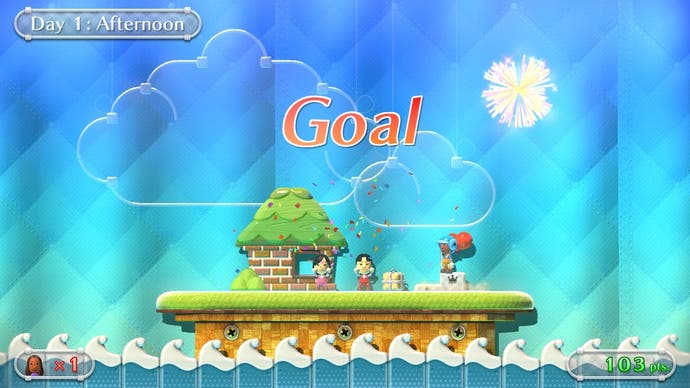
The Legend of Zelda: Battle Quest is a simpler affair. Borrowing the Motion Plus swashbuckling from Skyward Sword and the gyro-powered archery from Ocarina of Time 3D, this has a team of swordsmen and one archer moving through 16 levels of on-rails monster-mashing. It's punchy and hard, it's rewarding, and it's stunningly pretty.
And then there's Pikmin Adventure. The standout game of the whole package, this is a violently entertaining dungeon crawl that it's almost disrespectful to call a mini-game. You can play as Olimar, chucking Pikmin at enemies and crates with taps of the stylus on the GamePad screen, or with a remote you can play as a Mii in a Pikmin hat, leaping on the backs of clockwork Bulborbs and whacking them with your leaf. Either can level up to unlock new abilities and pick up power-ups like the hilarious hammer leaf. You won't want the 16 levels of joyous fracas to end, but when they do then there's a riotous versus mode in which a team of Pikmin players attempt to destroy waves of enemies faster than Olimar.
Pikmin Adventure is the best team game to play on your own; all three work well enough this way, but all three are much improved in company. Despite the ostensibly large proportion of solo-friendly games, you really should only consider Nintendo Land if you have people to play it with. It may not have the faultlessly broad appeal of Wii Sports, but it is perfect for families. And with the asymmetrical multiplayer idea inspiring a range of interesting and mischievous multiplayer dynamics, this is a true social game - so much so that it should make Zynga blush for co-opting the term.
"Does it explain the Wii U? No, and maybe it's wrong of us - and Nintendo - to expect it to."

None of the games is bad, but between a few throwaway solo attractions and the repetitious competitive games, Nintendo Land's focus could certainly have been tighter. It's more killer than filler, though - and it's great value, with a huge breadth and depth of content backed up by rock-solid design, genuine challenge and winsome attention to detail. It's easy to take for granted because it's a Nintendo release, but no one else makes mini-game compilations that come even close to this standard.
Does it explain the Wii U, though? No, and maybe it's wrong of us - and Nintendo - to expect it to. The Wii was a magic bullet, an engineering and marketing high concept, so it suited the sloganeering game design of Wii Sports. Wii U, by contrast, is Frankenstein's console, a strange assemblage of divergent technologies and ideas, and in that sense it's more like the DS (which, lest we forget, was initially greeted with confusion and derision). One game won't make it.
So maybe it's better to judge Nintendo Land on its own merits. Do that and you might be surprised. It's not just half a dozen great diversions and a few more besides; it's sweet fan service that celebrates Nintendo's catalogue with more heart and less calculation than we've seen of late. Better yet, it reclaims the used and abused mini-game compilation from the hollow hinterlands of the casual cash-in, lovingly restores it and puts it back where it belongs - amid the hustle, the buzz, the urgent appeal of the arcade. Roll up, roll up!
This game was played for review at Nintendo's UK offices before we received our own Wii U. No other press were present, we received no hospitality and we covered our own expenses.
